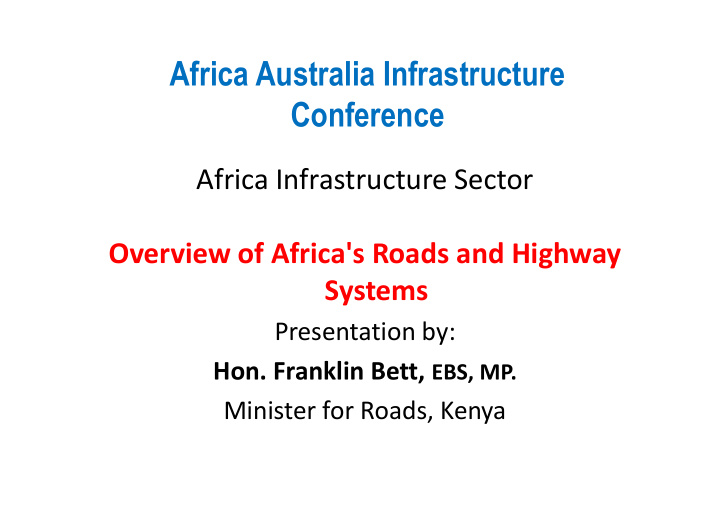



Africa Australia Infrastructure Conference Africa Infrastructure Sector Overview of Africa's Roads and Highway Systems Presentation by: Hon. Franklin Bett, EBS, MP. Minister for Roads, Kenya
Roads Sector Management - Gains Made • Institutional Reforms in Africa have generally moved well • Several countries have instituted secondary and sustainable sources for road financing, supported by Fuel Tax (Road Maintenance Levy) • Majority of road networks in Sub-Saharan African countries are showing marked signs of improvement
Trans-African Road Corridors The Trans- African Highway system consists of Nine (9) main corridors: Corridor Description Length (km) Highway 1 Cairo- Dakar 8,640 Highway 2 Algiers – Lagos 4,500 Highway 3 Tripoli – Windhoek 8,610 Highway 4 Cairo – Gaborone 8,860 Highway 5 Dakar – N’djamena 4,500 Highway 6 N’djamena – Djibouti 4, 220 Highway 7 Dakar – Lagos 4,010 Highway 8 Mombasa – Lagos 6,260 Highway 9 Beira – Lobito 3,520 Total length (km) 54,120
Trans-African Road Corridors • Africa is known to be one of the richest continents in natural resources, but the resources remain untapped due to transportation challenges. • Africa Region’s trunk road network comprises some 52,000 km of trade corridors linking seaports to economic hinterlands. • More than $200 billion worth of Africa’s annual trade is carried on only 10,000 km of it’s corridors.
Trans-African Road Corridors
Africa’s Missing Links Internal Country Links • This category should be prioritized by respective governments • Regional Economic Communities (e.g. SADCC, COMESA, ECOWAS,EAC) should actively review possible funding options available to national governments. Missing inter-country links • Viable links should be financed from external organizations that pay special attention to corridors with specific regional development profiles (eg African Development Bank) • Should be supported by the respective Regional Economic Communities in the application for funding, agreement on common standards in design, procurement, construction and supervisory services.
LAPSSET: Additional Corridor in Kenya • One of the Missing Links identified in the Trans-African Highway System • Kenya, South Sudan and Ethiopia are investing in the new corridor across Africa’s belt. • The Transport Corridor will connect Kenya’s deep port in Lamu to Southern Sudan, Ethiopia and onwards to Central Africa. • The corridor will consist of: • Oil Pipeline – 1,700 km (South and Turkana to Lamu) • Road – 1,800 km (including link to Ethiopia) • Railway – 2,300 km (including Ethiopia branch line) • When complete, LAPSSET will form part of a ‘Land Bridge’ connecting the Indian and the Atlantic Oceans
LAPSSET – Development Objectives LAPSSET is a ‘ Kenya Vision 2030 ’ flagship project, with the following objectives: - Foster transport linkage between Kenya, South Sudan and Ethiopia. - Dynamic promotion of regional socio-economic development along the transport corridor especially in the Northern, Eastern, North- Eastern and Coastal parts of Kenya. - Economic development of the region through enhanced cross-border trade. 9
LAPSSET Road Corridor in Kenya • Lamu - Isiolo - Lodwar - Nadapal :1270 km • Isiolo -Moyale : 530 km
Africa’s Highway System: What are the Challenges? Road Transport Infrastructure in Africa is still lagging other regions. Inefficiencies in the Transport Chain - it costs three times more to transport a 20 foot container from Mombasa to Kampala (600 miles) than from China to Mombasa (6,000 miles). Institutional disparities in urban and rural mobility. Road Traffic Accidents is a leading cause of mortality and public health concern.
What are the Challenges? If unchecked, deaths and disability from Road Traffic Accidents will cause an even greater toll on African economies. Traffic crashes affect mostly the poor and vulnerable groups. Traffic Congestion - rapidly becoming a major development problem in cities and urban areas.
What needs to be done? Africa needs to: • Spend about 2% of it’s GDP every year to improve transport infrastructure connectivity. • Complete Institutional Reforms in Roads Sector Management. • Increase Rural Accessibility and develop urban transport services. • Preserve developed networks - put more emphasis on maintenance efficiency and effectiveness rather than new roads.
What needs to be done? • Address funding gaps for road transport using • Infrastructure Bonds (where appropriate) • Concessionary Loan Schemes • Private Sector Finance • Employ alternative delivery options, including Performance Based maintenance contracting. • Funding development of missing regional links. • Adoption of harmonized standards for cross border corridors.
What needs to be done? • Encourage Private Sector investment on viable highway sections through PPP. • Build internal capacity for road management • Invest in transit and trade facilitation instruments to simplify and harmonize cross border procedures. • Liberalize road freight services to enable self regulation of players. • Mobilize funds to construct missing links within the Trans-African Highway System.
What needs to be done? • Improve Road Safety Standards and enforcement. • Control Overloading , including adoption of harmonized axle load limits • Use of appropriate technology to address escalating unit costs for construction and maintenance. • Build local capacity in road asset financing, construction and management.
Required Spending in Transport Infrastructure To meet Africa’s desired connectivity standards, Africa needs to invest on development of road infrastructure some US$ 13 billion every year for the next 10 years. Currently, the Infrastructure gap in Africa is estimated at US$ 300 billion, and is growing. Source: AfDB
Required Spending in Transport Infrastructure Cost Estimates Mode (US$ millions p.a.) Regional 2,678 National 2,877 Roads Rural 2,477 Urban 2,147 Railways 776 Other Modes Ports 876 Airports 856 Total 12,689 Totals % of GDP 2 Source: World Bank
Africa’s Opportunities • Road infrastructure connectivity enhancement will facilitate the exploitation of Africa’s vast natural resources, while contributing significantly to its GDP growth. • Africa’s infrastructure funding gap provides a great opportunity for public and private investment. • Africa’s fortunes can change rapidly with concerted investment efforts in transportation infrastructure.
The End Thank You
Recommend
More recommend